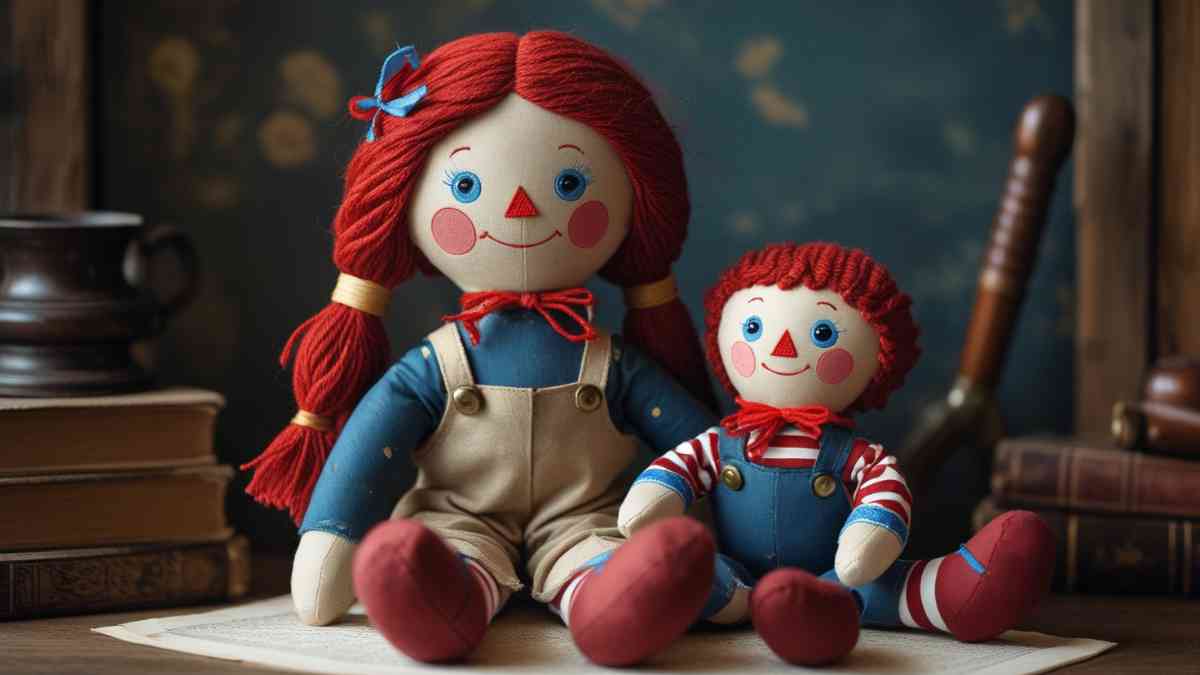Raggedy Ann Doll: A Timeless Icon of American Childhood

The Raggedy Ann doll holds a place of honor in the hearts of generations of children and collectors alike. Introduced more than a century ago, she is more than just a toy—she is a symbol of comfort, tradition, and innocence. With her distinctive red yarn hair, triangle nose, and endearing smile, Raggedy Ann became a beloved figure across America and far beyond.
The story of Raggedy Ann began in 1915 when illustrator and writer Johnny Gruelle created the character. Inspired by a homemade rag doll found in the attic and given to his daughter Marcella, Gruelle added a whimsical face, stitched in personality, and named her Raggedy Ann. The name itself was a creative fusion of two James Whitcomb Riley poems: “The Raggedy Man” and “Little Orphant Annie.”
From Page to Plush
Raggedy Ann first appeared in print in 1918 in Raggedy Ann Stories, a collection of short tales written and illustrated by Gruelle. The book was an instant success, prompting the production of matching cloth dolls to accompany it. A few years later, in 1920, Gruelle introduced Raggedy Andy—her mischievous yet lovable brother—in Raggedy Andy Stories. Together, the raggedy ann and andy dolls became an inseparable pair in the toy world.
Each story carried gentle morals and emphasized kindness, friendship, and resilience—virtues that resonated deeply with families, especially in the aftermath of World War I.
Cultural Significance Across the Decades
What makes the raggedy ann doll a timeless cultural icon is not just her charm, but her ability to adapt and endure. Throughout the Great Depression, World War II, and the post-war boom, Raggedy Ann continued to provide children with comfort and companionship. Her simplistic, homespun look was a nostalgic reminder of hand-made values in an increasingly industrialized world.
In 2002, Raggedy Ann was officially inducted into the National Toy Hall of Fame, a recognition that solidified her place in history. Her brother, Raggedy Andy, followed in 2007, confirming the enduring popularity of the raggedy ann and andy dolls duo.
Anatomy of the Raggedy Ann Doll
While styles have evolved over the years, the essential features of a raggedy ann doll have remained surprisingly consistent:
-
Red yarn hair: Distinctive and playful.
-
Button eyes or stitched eyes: Depending on the version, but always radiating warmth.
-
Triangle nose and red smile: A signature part of her friendly expression.
-
Calico dress and white apron: Often decorated with a small heart or the word “I Love You.”
-
Striped stockings and black shoes: Giving her a classic Americana feel.
-
Heart with a message: Many traditional dolls have a heart stitched inside that reads “I love you.”
These elements contribute to the doll’s enduring identity and emotional resonance.
Evolution Through Manufacturers
Over the decades, many companies have held licenses to produce the doll, including:
-
P.F. Volland Company – the first to commercialize the dolls in tandem with Gruelle’s books.
-
Knickerbocker Toy Company – a key manufacturer during the mid-20th century.
-
Hasbro – modernized versions through large-scale production.
-
Aurora World Inc. – currently holds the exclusive rights to plush dolls since 2012.
Each era brought subtle changes in materials and design, but the essence of the doll remained rooted in tradition.
Raggedy Ann in Media
The popularity of the raggedy ann dolls extended far beyond books and shelves. She was the star of several animated specials and theatrical productions. In 1977, Raggedy Ann & Andy: A Musical Adventure brought the characters to life on the big screen.
Throughout the years, TV appearances, merchandise, lunchboxes, and Halloween costumes helped keep Raggedy Ann a visible figure in pop culture. Parents who had grown up with her began passing down their cherished dolls to their children, creating a beautiful cycle of connection across generations.
A Collector’s Treasure
While many think of the raggedy ann doll as a child’s toy, she has also become a serious collector’s item. Vintage Raggedy Ann and Andy dolls from the early 1900s, especially those made by the original manufacturers or signed by Johnny Gruelle, can fetch thousands of dollars in auctions.
Collectors look for:
-
Original stitching and fabric.
-
Early manufacturer tags.
-
Matching pairs (Ann and Andy).
-
Handmade dolls from the early 20th century.
But beyond monetary value, collectors often speak of the sentimental attachment, the stories of childhood, and the emotion each doll carries.
Why Raggedy Ann Still Matters Today
The secret to the raggedy ann doll’s timeless appeal lies in her simplicity. In an age where toys are high-tech and often overstimulating, Raggedy Ann offers something uniquely calming—an invitation to imagination.
She’s not battery-powered. She doesn’t talk or walk or light up. Instead, she encourages storytelling, pretend play, and emotional bonding. For many children, she becomes a best friend, a confidant, and a bedtime companion.
In an era defined by screens and speed, the Raggedy Ann doll teaches the importance of slowing down, embracing comfort, and cherishing nostalgia.
The Sentimental Connection
Part of the magic of Raggedy Ann is the way she becomes a deeply personal object. Families pass her down from mother to daughter, cousin to cousin. She becomes a fixture on bookshelves, toy chests, and memory boxes.
She’s often gifted at baby showers, birthdays, and even graduations. Each doll, no matter how faded or torn, carries its own history—a silent witness to years of childhood adventures and milestones.
Preserving the Legacy
Today, fans of the raggedy ann and andy dolls can still find them in various forms—traditional cloth dolls, figurines, modern adaptations, and even digital collectibles. But what remains most valuable is preserving the spirit of Raggedy Ann.
Organizations and doll museums across the U.S., particularly in Gruelle’s hometown of Arcola, Illinois, continue to celebrate her legacy through exhibitions, events, and storytelling sessions.
Raggedy Ann as a Symbol
More than a doll, Raggedy Ann has become a symbol of resilience. Her smiling face has comforted children during sickness, helped them cope with grief, and served as a reminder of home during tough times.
In some hospitals and therapy settings, Raggedy Ann dolls are still used to comfort young patients. Their softness and familiarity offer emotional grounding—proving once again that the most powerful toys are not always the most complicated.
Conclusion
The story of the raggedy ann doll is not just about fabric and thread—it’s about love, memory, and timeless charm. In every stitch lies a piece of history, and in every smile lies a whisper of childhood joy.
Whether you’re a long-time collector, a curious parent, or someone rediscovering a childhood friend, Raggedy Ann will always be more than just a doll. She is a story you can hold in your arms—a gentle reminder that sometimes, the simplest things leave the most lasting impressions.
Rediscover the magic of childhood—bring home your own Raggedy Ann doll today.



